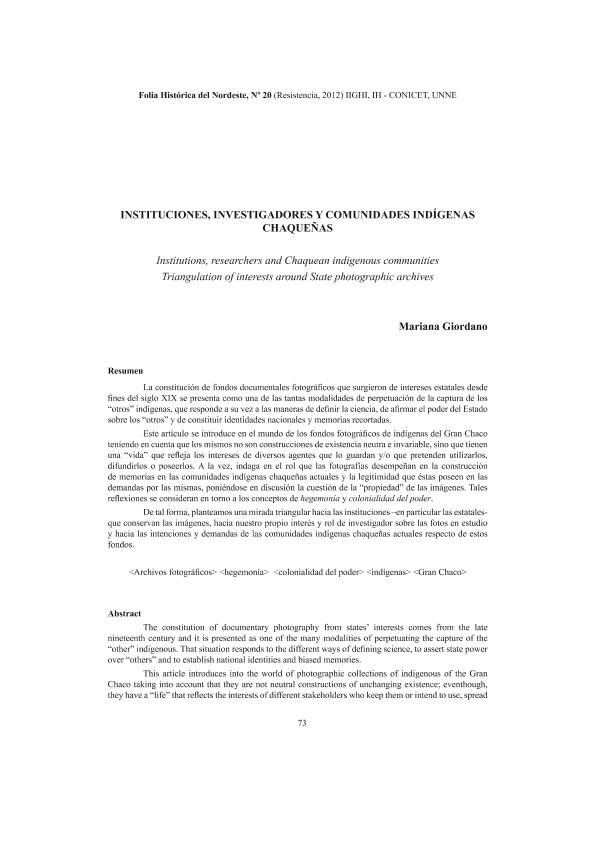Artículo
La constitución de fondos documentales fotográficos que surgieron de intereses estatales desde fines del siglo XIX se presenta como una de las tantas modalidades de perpetuación de la captura de los “otros” indígenas, que responde a su vez a las maneras de definir la ciencia, de afirmar el poder del Estado sobre los “otros” y de constituir identidades nacionales y memorias recortadas. Este artículo se introduce en el mundo de los fondos fotográficos de indígenas del Gran Chaco teniendo en cuenta que los mismos no son construcciones de existencia neutra e invariable, sino que tienen una “vida” que refleja los intereses de diversos agentes que lo guardan y/o que pretenden utilizarlos, difundirlos o poseerlos. A la vez, indaga en el rol que las fotografías desempeñan en la construcción de memorias en las comunidades indígenas chaqueñas actuales y la legitimidad que éstas poseen en las demandas por las mismas, poniéndose en discusión la cuestión de la “propiedad” de las imágenes. Tales reflexiones se consideran en torno a los conceptos de hegemonía y colonialidad del poder. De tal forma, planteamos una mirada triangular hacia las instituciones –en particular las estatalesque conservan las imágenes, hacia nuestro propio interés y rol de investigador sobre las fotos en estudio y hacia las intenciones y demandas de las comunidades indígenas chaqueñas actuales respecto de estos fondos. The constitution of documentary photography from states’ interests comes from the late nineteenth century and it is presented as one of the many modalities of perpetuating the capture of the “other” indigenous. That situation responds to the different ways of defining science, to assert state power over “others” and to establish national identities and biased memories. This article introduces into the world of photographic collections of indigenous of the Gran Chaco taking into account that they are not neutral constructions of unchanging existence; eventhough, they have a “life” that reflects the interests of different stakeholders who keep them or intend to use, spread or possess them. Besides, we analyze the role that these photographs have in building memories within Chaco indigenous communities today. Therefore, we also call into question the copyright or “property” of images. These reflections are considered around the concepts of hegemony and coloniality of power. Thus, there is a triangular look towards the institutions, -including state ones- that preserved the images, to our own interest and our role as researchers on photos and into the intentions and demands of Chaco indigenous communities.
Instituciones, investigadores y comunidades indígenas chaqueñas: Triangulación de intereses en torno a fondos fotográficos estatales
Título:
Institutions, researchers and Chaquean indigenous communities: Triangulation of interests around State photographic archives
Fecha de publicación:
12/2012
Editorial:
Consejo Nacional de Investigaciones Científicas y Técnicas. Instituto de Investigaciones Geohistóricas
Revista:
Folia Histórica del Nordeste
ISSN:
0325-8238
e-ISSN:
2525-1627
Idioma:
Español
Tipo de recurso:
Artículo publicado
Clasificación temática:
Resumen
Palabras clave:
Archivos Fotográficos
,
Hegemonía
,
Colonialidad del Poder
,
Indígenas
,
Gran Chaco
Archivos asociados
Licencia
Identificadores
Colecciones
Articulos(IIGHI)
Articulos de INST.DE INVEST.GEOHISTORICAS (I)
Articulos de INST.DE INVEST.GEOHISTORICAS (I)
Citación
Giordano, Mariana Lilian; Instituciones, investigadores y comunidades indígenas chaqueñas: Triangulación de intereses en torno a fondos fotográficos estatales; Consejo Nacional de Investigaciones Científicas y Técnicas. Instituto de Investigaciones Geohistóricas; Folia Histórica del Nordeste; 20; 12-2012; 73-92
Compartir
Altmétricas




